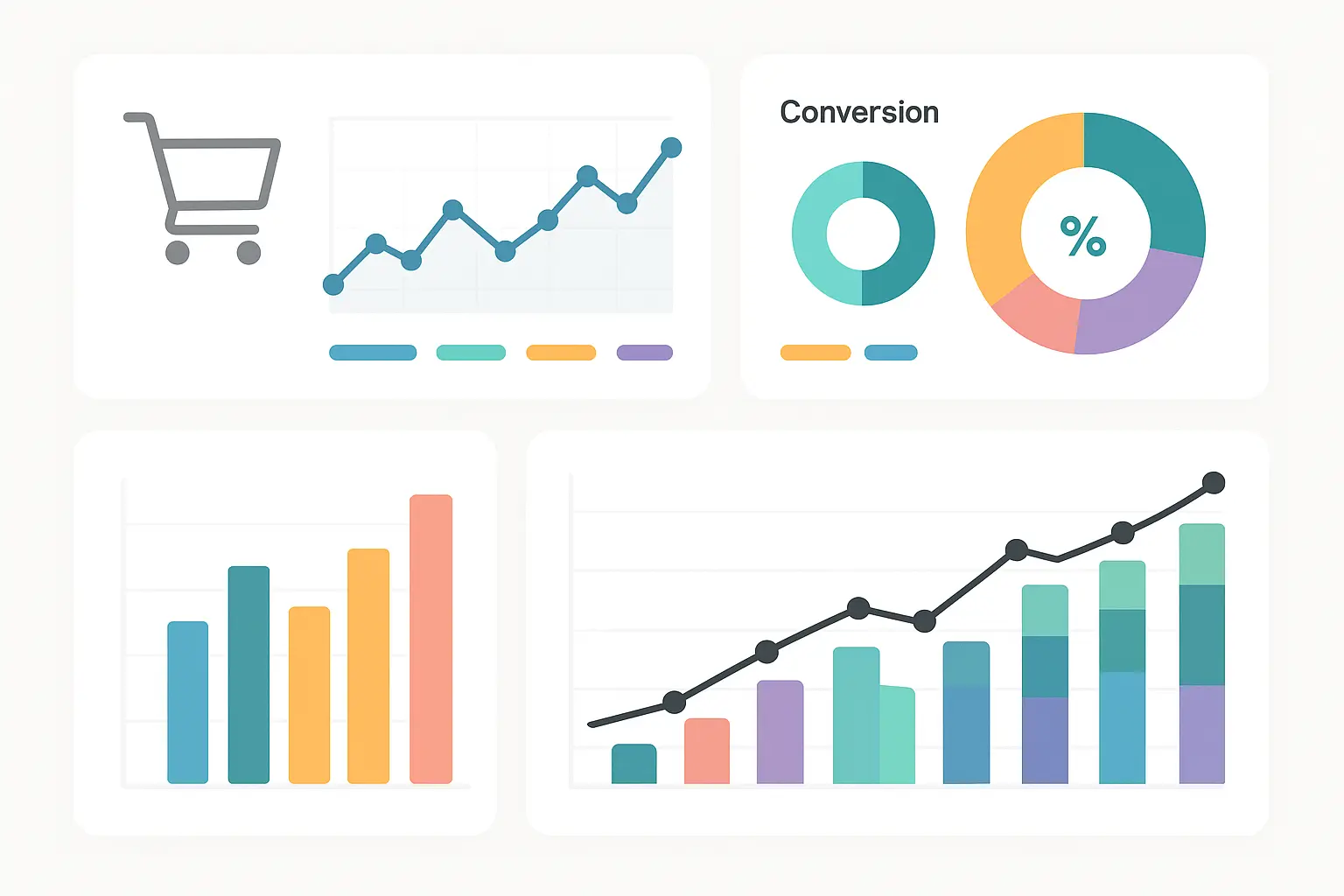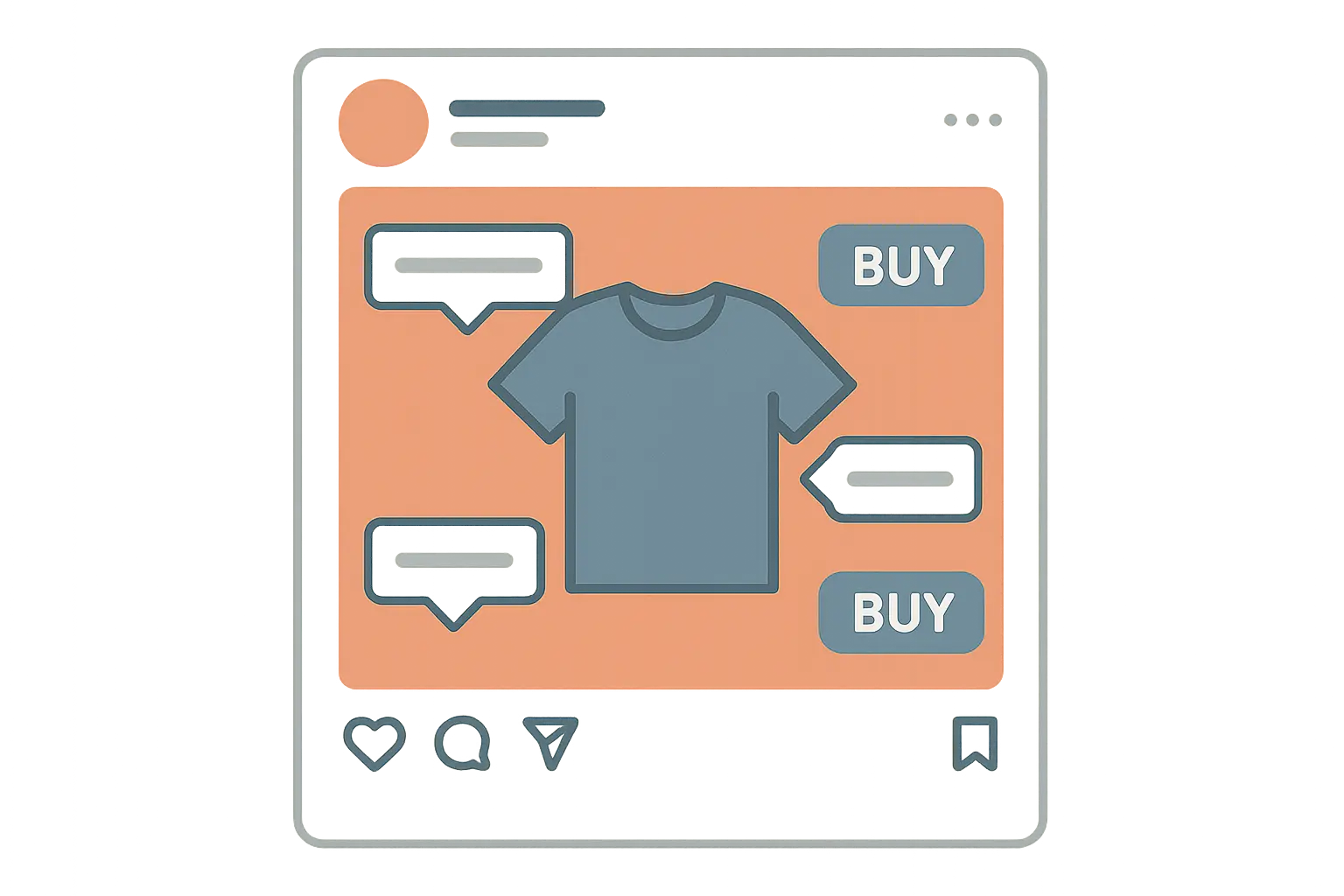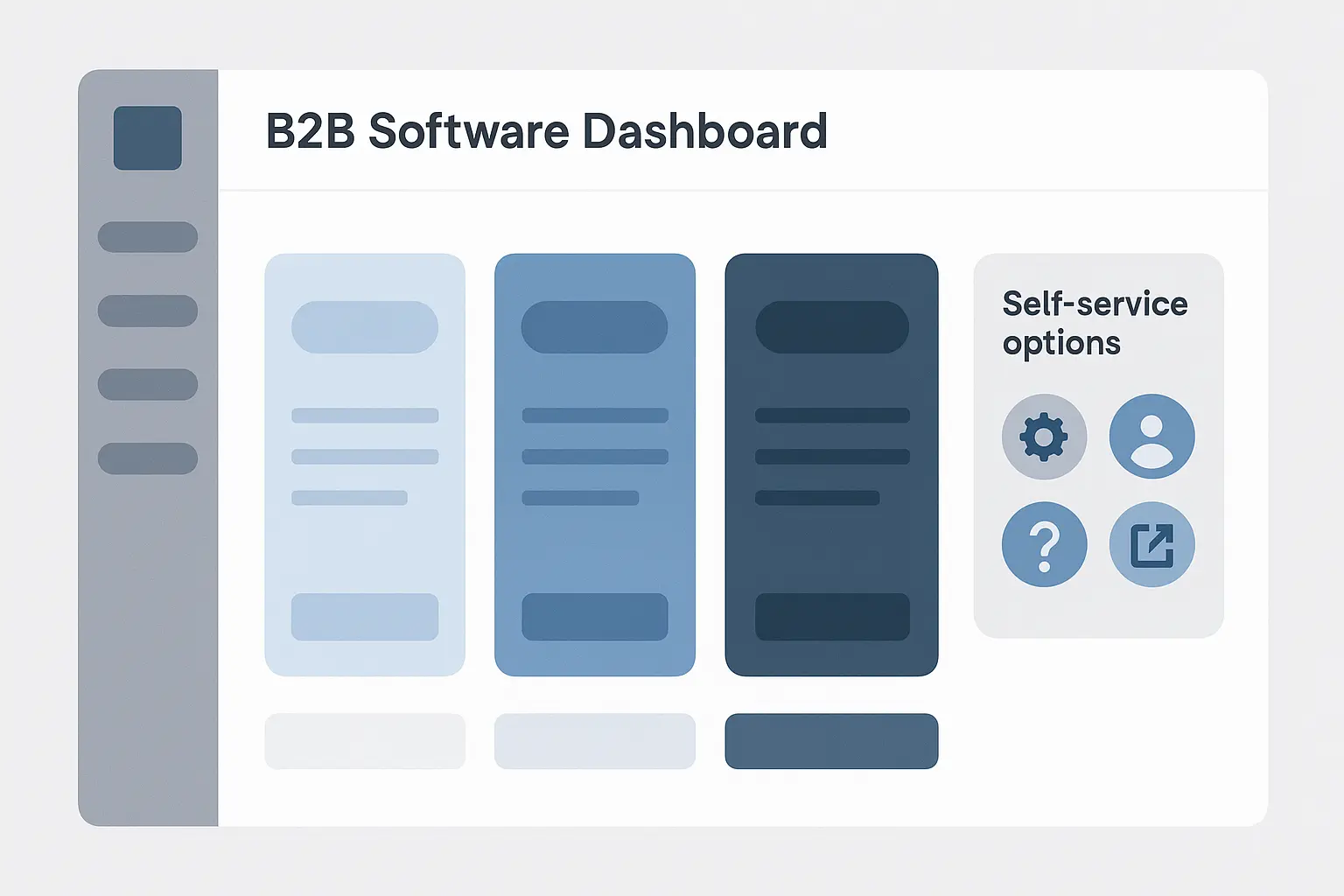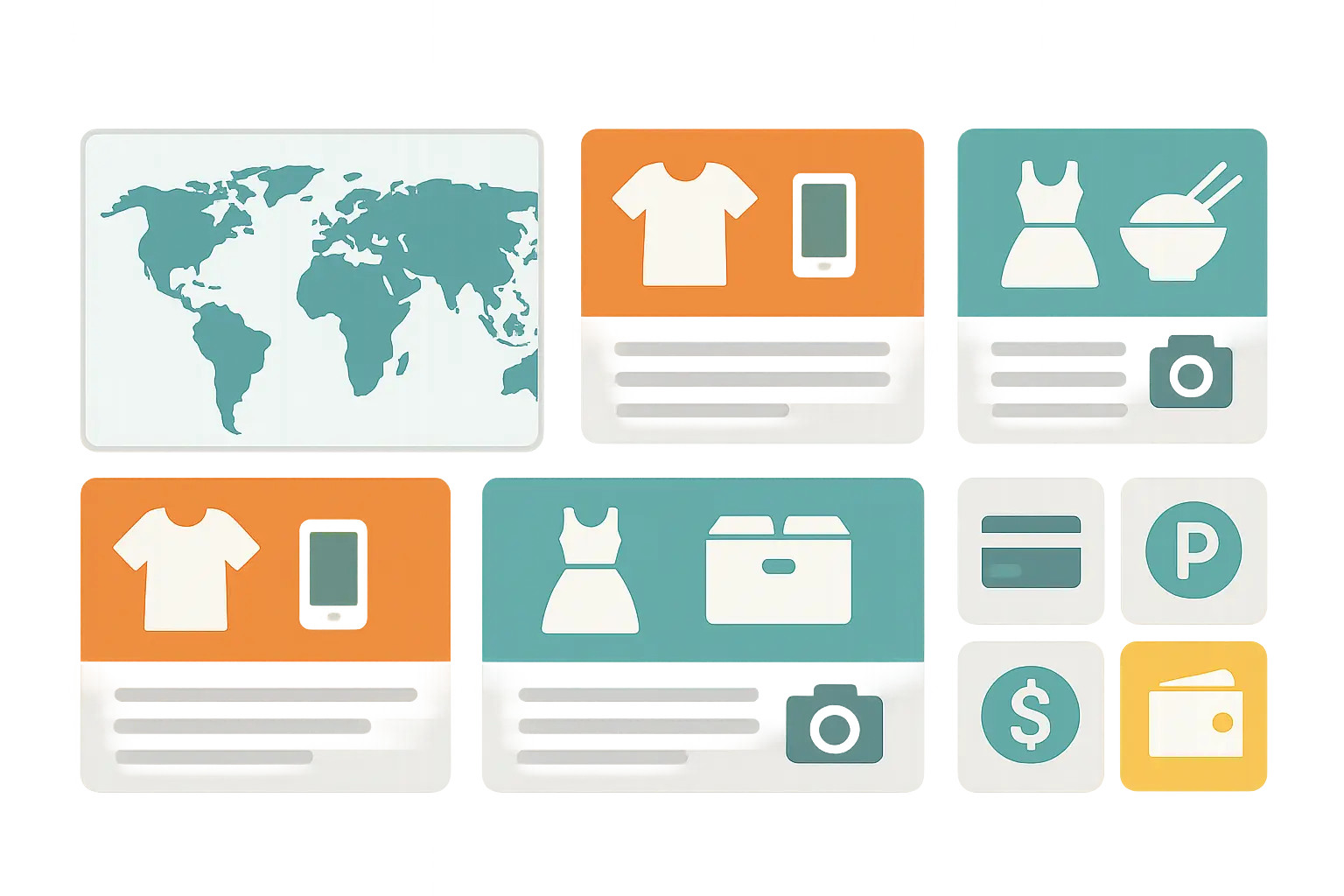So I was procrastinating on my quarterly review last week (don’t judge me), scrolling through analytics when this stat basically slapped me in the face: with over 33% of the world’s population shopping online, eCommerce is now a $6.8 trillion industry and will reach the $8 trillion mark by 2027. That’s when it hit me—I’d been treating case studies like light bedtime reading instead of the absolute goldmine they actually are.
You know that gut-wrenching feeling when you’re stuck watching your conversion rates flatline while your competitors seem to have cracked some secret code? Yeah, I’ve been there too many times to count. That’s exactly why I went down this rabbit hole, diving deep into 25 game-changing ecommerce case studies that reveal what’s actually working for the most successful online businesses right now.
Look, these aren’t your typical “we increased sales by 10% and called it a day” stories. We’re talking about companies that achieved 600% traffic growth (seriously), 102.5% conversion improvements, and built billion-dollar brands from literally nothing. More importantly, I’ll show you exactly how to figure out which strategies will actually work for your business instead of just looking impressive on paper.

Table of Contents
-
What Actually Makes a Case Study Worth Your Time (Spoiler: Most Aren’t)
-
The Companies That Finally Figured Out CRO
-
Customer Acquisition Masters Who Don’t Rely on Facebook Ads
-
Email Marketing That Actually Gets Opened (And Converts)
-
How Some Brands Turned Social Media Into a Sales Machine
-
B2B Ecommerce Leaders Who Made Complex Sales Simple
-
Global Expansion Done Right (Without Losing Your Shirt)
-
Three Case Studies That Deserve a Deeper Look
-
How to Stop Picking the Wrong Strategies for Your Business
-
Turning All This Inspiration Into Actual Results
-
Final Thoughts
TL;DR
Here’s the stuff that actually matters if you’re in a hurry:
-
Most case studies are garbage, but the good ones share specific metrics, realistic timeframes, and methods you can actually copy
-
Sometimes the simplest changes win big—Basecamp doubled conversions just by going from 4 pricing options to 2 (I’m still wrapping my head around this one)
-
Community beats paid ads every single time—Glossier got 600% organic traffic growth by letting customers do the marketing for them
-
Mobile isn’t just important anymore, it’s everything—ASOS saw 35% conversion increases just by making their mobile pages actually usable
-
Personalization works, but only if you do it right—Sephora’s AI campaigns boosted repeat purchases by 40%, but this isn’t a weekend project
-
B2B ecommerce is completely different from consumer stuff—focus on self-service and account-based marketing, not impulse buys
-
Going global means way more than translating your website—payment methods and cultural preferences matter more than perfect grammar
What Actually Makes a Case Study Worth Your Time (Spoiler: Most Aren’t)
I’ll be honest – I used to bookmark every case study I found, thinking I was being super productive. Spoiler alert: I wasn’t. After wasting countless hours on mediocre case studies (seriously, some of them were painful to read), I finally figured out how to separate the gold from the complete garbage.
Here’s the thing that took me way too long to learn: most case studies are either too vague to be useful or completely irrelevant to your specific situation. The game-changer? Actually having a system to evaluate them before you waste three hours reading about someone else’s “revolutionary” strategy.
The most valuable ecommerce case study examples need to check these boxes: they match your business model (learned this one the hard way), show real numbers with clear ROI data, give you enough detail to actually implement something, come from credible sources that aren’t just making stuff up, and work with whatever platform you’re already using. When you’re evaluating case studies, it helps to understand advanced case study success strategies that separate the wheat from the chaff.
Okay, so I’ve been tracking this stuff obsessively (my team thinks I’m crazy), and here’s what actually matters when you’re evaluating case studies:
The Good Stuff:
-
Specific metrics that don’t make you roll your eyes – like “102.5% conversion increase over 6 months” instead of the usual “significant improvement” BS
-
Clear methodology you can actually follow – not some vague “we changed our approach” nonsense
-
Business model that matches yours (learned this one the hard way when I tried applying B2B tactics to my D2C brand… awkward)
-
Realistic timeframes – “3-month implementation with monthly milestones” beats “overnight success” every time
-
Investment transparency – knowing they spent $50K to make $200K helps you plan accordingly
The Red Flags That’ll Waste Your Time:
-
Vague claims like “significant improvement” (what does that even mean?)
-
“Changed our approach and saw results” (thanks for nothing)
-
Trying to apply enterprise software tactics to your fashion brand (been there)
-
“Overnight success” stories with no timeline (sure, Jan)
-
No mention of what it actually cost them (probably because it was astronomical)
Business Model Alignment: Don’t Make My Mistakes
Look, your business model determines everything about how customers interact with your brand. I spent three weeks trying to implement Dollar Shave Club’s checkout optimization before realizing our B2B customers actually wanted more information, not less. B2C companies can definitely learn from their tactics, but B2B buyers expect detailed specs and approval workflows – totally different game.
Industry relevance matters more than you’d think too. A fashion brand’s Instagram strategy won’t translate directly to selling industrial equipment, even though they’re both “ecommerce.” I mean, come on – when’s the last time you saw someone posting a thirst trap with a forklift?
Company size creates another filter I wish I’d understood earlier. Startup strategies that work with limited resources often completely fall apart at enterprise scale. Meanwhile, enterprise solutions might be total overkill for smaller operations (and your budget will hate you for trying).
Show Me the Real Numbers
Vague claims like “significant improvement” or “substantial growth” make me want to throw my laptop across the room. Quality case studies give you the actual numbers: conversion rates, revenue percentages, customer acquisition costs, and realistic timeframes.
Here’s what really matters though – the investment-to-return ratio. A 50% conversion increase sounds amazing until you find out it required a $500K technology overhaul and six months of development time. Been there, and my CFO still brings it up in meetings.
Beyond Surface-Level Tactics
Surface-level case studies tell you what happened. The valuable ones explain why it worked and how you can actually adapt it without hiring a team of consultants. They’re honest about how complex implementation really is and what roadblocks you’ll probably hit.
Scalability is huge too. A manual customer service approach might work great for 100 orders per month, but it becomes a nightmare at 10,000. Ask me how I know (actually, don’t – it’s still too painful).
Making Sure They’re Not Just Making Stuff Up
Source reliability matters enormously in our age of manufactured success stories. Third-party validation, platform-specific data, and independent verification add way more credibility than self-reported metrics that could be completely fabricated.
Methodology transparency is what lets you actually replicate results. Case studies that explain their testing procedures, sample sizes, and measurement criteria give you a roadmap. The ones that don’t are basically just expensive fiction.
The Companies That Finally Figured Out CRO
Conversion rate optimization feels like trying to solve a puzzle blindfolded sometimes – you make tiny changes and pray for massive results. These four companies prove that when you get it right, the results can be absolutely wild. We’re talking about simplifying user experiences, mobile-first design that actually works, systematic testing that doesn’t drive you insane, and reducing decision complexity without dumbing things down.

1. Dollar Shave Club – They Made Checkout Actually Simple
Cart abandonment was absolutely destroying Dollar Shave Club’s growth. Their multi-step checkout process was like an obstacle course – way too many opportunities for customers to bail out and second-guess themselves.
The solution seemed almost too obvious in hindsight: mash everything into a single-page checkout with guest options. No forcing people to create accounts, no unnecessary form fields, no confusing bouncing between different pages.
The results still blow my mind: 15% increase in conversion rates and 23% reduction in cart abandonment. The lesson here? Every single additional step in your checkout is basically an exit ramp for customers who are already on the fence.
Here’s exactly what Dollar Shave Club changed:
-
Before: 4-step checkout nightmare requiring account creation, separate billing/shipping pages, and payment confirmation that felt like filing taxes
-
After: Single-page checkout with guest option, combined billing/shipping form, and one-click payment processing that actually worked
-
The nitty-gritty: Eliminated forced account creation (thank god), cut form fields from 23 to 8, added progress indicators so people knew they weren’t stuck in checkout purgatory
-
Timeline: 6 weeks of development and 2 weeks of A/B testing (not exactly overnight, but reasonable)
-
Results: 15% conversion boost, 23% fewer abandoned carts, 12% faster checkout completion
2. ASOS – Mobile Pages That Don’t Suck
ASOS discovered their mobile conversion rates were absolutely terrible compared to desktop, which was a problem since most of their traffic was coming from mobile. Their traditional product pages designed for desktop created the kind of mobile experience that makes you want to throw your phone.
Their redesign put mobile interactions first from day one. Swipe functionality replaced those tiny thumbnail clicks that nobody could actually hit, simplified navigation reduced the cognitive load, and touch-optimized buttons that you could actually press without a magnifying glass.
The payoff was huge: 35% increase in mobile conversions and 28% boost in mobile revenue. This case study hammers home why mobile-first design isn’t just about making things smaller – it’s about completely rethinking how people actually use their phones.
3. Unbounce – A/B Testing That Actually Works
Unbounce was driving quality traffic to their campaign landing pages but watching conversion rates stay stubbornly low. Instead of playing the guessing game (which I’ve done way too many times), they got systematic about A/B testing.
Their testing approach focused on changing one thing at a time: headlines, call-to-action buttons, page layouts, and form designs. Each test ran until they hit statistical significance, which means the results were actually reliable instead of just random noise.
The systematic approach delivered a 41% improvement in conversion rates across their tested pages. More importantly, they built a process for continuous optimization instead of just hoping for one-time lightning in a bottle.
4. Basecamp – Less Really Is More
This one still gives me chills – Basecamp’s pricing page was confusing potential customers with four different tiers, each loaded with varying features and limitations. Their analysis showed that choice paralysis was actually preventing conversions instead of enabling them.
The solution was bold: cut pricing options from four tiers down to just two clear choices. This eliminated confusion and made the decision process straightforward instead of requiring a spreadsheet to compare options.
Results exceeded everyone’s expectations with a 102.5% increase in conversions from the pricing page. Like, how do you even explain that to your boss without sounding like you’re making it up? This case study proves that sometimes less really is more in ecommerce design.
Customer Acquisition Masters Who Don’t Rely on Facebook Ads
Traditional advertising gets more expensive every year (thanks, iOS 14), but these companies figured out sustainable customer acquisition that doesn’t make your CFO cry. Their strategies focus on creating actual value first and selling second. These case studies show how community-driven content, innovative tech solutions, comprehensive SEO strategies, and strategic influencer partnerships can drive crazy traffic growth and customer acquisition without burning through your ad budget.
5. Glossier – Community-Driven Content That Actually Works
Glossier entered a beauty market absolutely dominated by established brands with advertising budgets bigger than most companies’ entire revenue. Traditional marketing would’ve been prohibitively expensive and probably wouldn’t have broken through all that noise anyway.
Their community-first strategy encouraged customers to share makeup-free selfies and honest product reviews. This user-generated content created genuine connections that no amount of traditional advertising budget could buy.

The social listening component actually informed their product development, creating this feedback loop where customers felt genuinely heard and valued. The “Glossier You” platform amplified customer stories and tips, building community around shared experiences instead of just pushing products.
Results were absolutely extraordinary: 600% increase in organic traffic, 2M+ Instagram followers with insane engagement rates, and 70% of new customers came through word-of-mouth. The lesson? Authentic community beats paid advertising every single time, but it’s way harder to execute than it sounds.
6. Warby Parker – Virtual Try-On That Doesn’t Suck
Buying prescription glasses online seemed completely impossible due to fit and style concerns. Warby Parker needed to solve this fundamental barrier that was keeping people from making online eyewear purchases.
Their dual approach combined AR-powered virtual try-on technology with an innovative home try-on program. Customers could preview glasses digitally through their mobile app, then get five actual frames shipped to try at home for free.
The strategy addressed both convenience and confidence concerns simultaneously. Virtual try-on helped with initial selection, while home try-on provided that final validation before people committed to buying.
Results validated their approach: 50% conversion rate for customers who tried frames at home and 85% customer satisfaction rate. This case study shows how technology can solve fundamental industry challenges when you actually think about what customers need.
7. Casper – Content-Led SEO That Builds Trust
The mattress industry seemed impossible to differentiate until Casper focused on sleep education instead of just mattress features. Their content strategy targeted sleep-related problems rather than people who were already shopping for mattresses.
Comprehensive content covered sleep science, bedroom optimization, and wellness topics. This approach attracted customers way earlier in their journey, building trust long before they were ready to buy anything.
The SEO strategy created sustainable organic traffic growth that didn’t depend on paying Facebook every month. Educational content established Casper as a sleep authority instead of just another mattress company trying to get your attention.
Results demonstrated the power of content marketing
Results demonstrated the power of content marketing: 300% increase in organic traffic and $200M+ in annual revenue. The key insight? Solve problems first, sell products second – but be patient because this takes time to build.
8. Allbirds – Influencer Partnerships That Don’t Feel Fake
Allbirds needed to build credibility for sustainable footwear in a market dominated by Nike and Adidas with their massive marketing budgets. Traditional celebrity endorsements would’ve been expensive and probably felt completely inauthentic anyway.
Their influencer strategy focused on eco-conscious personalities and celebrities who genuinely cared about sustainability. These partnerships felt authentic because they matched what these influencers were already talking about.
The approach created credible third-party validation for both product quality and environmental claims. Influencers became genuine advocates instead of just paid spokespeople reading scripts.
Results proved the strategy worked: 200% year-over-year growth and $100M+ annual revenue. This case study highlights why authentic alignment matters way more than follower count in influencer partnerships.
Email Marketing That Actually Gets Opened (And Converts)
Email marketing might seem old-school compared to TikTok and whatever new platform launched this week, but these companies prove it’s still one of the highest-ROI channels when you don’t completely screw it up. The secret sauce is personalization and timing, not just blasting everyone with the same generic newsletter. These case studies show how AI-driven personalization, automated behavioral sequences, value-first educational content, and targeted win-back campaigns can dramatically improve email performance and keep customers coming back.
For businesses looking to implement similar email strategies, understanding professional email marketing solutions becomes crucial for actually pulling this stuff off.
Here’s what I’ve learned from analyzing these email strategies (and making plenty of mistakes myself):
AI-Driven Personalization: Machine learning analyzes purchase history and behavior patterns – works best when you have large customer databases with diverse product catalogs, delivers 60% open rate increases and 40% repeat purchase boosts
Behavioral Triggers: Automated campaigns based on what users actually do – perfect for SaaS platforms and subscription services, typically see 25% conversion increases and 18% churn reduction
Educational Series: Value-first content that teaches instead of sells – ideal for freemium models and complex products, often achieves 35% free-to-paid conversion with 90%+ open rates
Win-Back Campaigns: Personalized re-engagement using past behavior data – great for marketplaces and travel platforms
9. Sephora – Personalized Email That Actually Feels Personal
Sephora faced the nightmare of personalizing communications for millions of customers with completely different beauty preferences and purchase histories. Generic email campaigns weren’t moving the needle on engagement or repeat purchases – sound familiar?
Their AI-driven personalization engine analyzed purchase history, browsing behavior, and beauty profile data to create individualized email experiences. Each customer got product recommendations tailored to their specific needs instead of whatever Sephora was trying to push that week.

The system continuously learned from customer interactions, getting better at recommendations over time. This created a feedback loop where email performance improved as more data became available – pretty smart, actually.
Results were seriously impressive: 60% increase in email open rates and 40% boost in repeat purchase rate. The lesson? Personalization at scale requires serious technology investment, but it pays off big time in customer lifetime value.
10. Spotify – Behavioral Triggers That Don’t Feel Creepy
Spotify needed to reduce churn and get more free users to upgrade to premium without being annoying about it. Traditional promotional emails weren’t effectively converting users who were already engaged with the platform.
Their behavioral trigger system sent automated emails based on actual listening patterns and engagement levels. Users got different messages depending on how much they listened, what genres they loved, and how they interacted with premium features.
The campaigns felt natural because they responded to real user behavior instead of some arbitrary email schedule. This relevance made people actually want to open and read them instead of immediately hitting delete.
Results validated the approach: 25% increase in premium conversions and 18% reduction in churn. This case study shows how behavioral data drives way more effective email marketing than demographic guessing games.
11. Grammarly – Educational Email That Doesn’t Suck
Grammarly had high engagement with their free product but struggled to convert users to premium subscriptions. Users didn’t understand the value of advanced features they’d never experienced – classic freemium problem.
Their educational email series showcased premium features through practical writing tips and examples. Instead of just listing features, they demonstrated actual value through education that people genuinely wanted to read.
The approach built trust and expertise while naturally introducing premium capabilities. Users learned about advanced features in context, making the upgrade decision feel logical instead of pushy.
Results exceeded expectations: 35% increase in free-to-paid conversions and 90%+ email open rates. The key insight? Education-first email marketing builds value perception before asking for money.
Here’s exactly how Grammarly’s educational sequence worked:
-
Week 1: “5 Grammar Mistakes That Make You Look Unprofessional” (introduced basic correction features people already used)
-
Week 2: “Advanced Writing Techniques for Clearer Communication” (showcased tone detection premium feature through examples)
-
Week 3: “Industry-Specific Writing Guidelines” (demonstrated genre-specific suggestions without being salesy)
-
Week 4: “Plagiarism Prevention Best Practices” (introduced plagiarism checker premium feature naturally)
-
Week 5: “Writing Analytics: Understanding Your Communication Style” (showcased performance stats feature)
-
Results: 35% conversion increase, 90% series completion rate, 45% premium feature trial rate
12. Airbnb – Win-Back Campaigns That Actually Work
Airbnb faced the challenge of reactivating users who had searched for accommodations but hadn’t booked in months. Generic “we miss you” emails weren’t bringing dormant users back to the platform – shocking, I know.
Their personalized re-engagement campaign used past search and booking data to recommend relevant destinations. The emails felt helpful rather than desperate, which made all the difference in response rates.
Campaign timing coincided with seasonal travel patterns and personal milestones, increasing relevance and response rates. This strategic timing made the outreach feel natural instead of random spam.
Results demonstrated the power of personalized re-engagement: 30% re-engagement rate and $50M+ in recovered bookings. This case study proves that dormant customers aren’t lost customers – they just need the right message at the right time.
How Some Brands Turned Social Media Into a Sales Machine
Social media transformed from a brand awareness channel into a direct sales platform, but most brands still treat it like a billboard. These companies mastered the art of selling without feeling salesy on social platforms. These case studies show how Instagram Shopping integration, TikTok commerce strategies, Facebook Shop optimization, and Pinterest Shopping ads can convert social media buzz into actual sales while maintaining authentic brand storytelling.
13. Kylie Cosmetics – Instagram Shopping That Doesn’t Kill the Vibe
Kylie Cosmetics generated massive social media buzz but struggled to convert that engagement into immediate sales. The gap between social discovery and purchase completion was costing them serious money.
Instagram Shopping tags and Stories integration created seamless purchase paths directly from social content. Customers could buy products without leaving the Instagram app, which reduced friction significantly and kept people in the buying mood.

The strategy maintained the authentic feel of social content while enabling instant purchasing. Product tags felt natural within the content instead of intrusive advertising that made people want to scroll past.
Results were remarkable: 70% of traffic came from social media and $360M+ in annual revenue. This case study demonstrates how social commerce can become a primary sales channel when you don’t completely ruin the user experience.
14. Nike – TikTok Commerce That Gen Z Actually Likes
Nike needed to reach Gen Z consumers who were increasingly immune to traditional advertising. TikTok’s younger demographic represented a crucial growth opportunity that they couldn’t afford to mess up.
Their branded hashtag challenges and TikTok Shopping integration created engaging content that felt native to the platform instead of like obvious advertising. The campaigns encouraged user participation rather than passive consumption, which Gen Z actually responds to.
The approach leveraged TikTok’s algorithm to amplify user-generated content, extending reach way beyond paid promotion. This organic amplification multiplied the campaign’s effectiveness without requiring massive ad spend.
Results validated the strategy: 1B+ hashtag views and 45% increase in Gen Z customer acquisition. The lesson? Platform-native content performs infinitely better than repurposed advertising that screams “hello fellow kids.”
15. Patagonia – Facebook Shop That Actually Tells a Story
Patagonia needed to showcase their environmental mission alongside product sales on Facebook. Traditional product catalogs couldn’t effectively communicate their sustainability story, which is literally their entire brand.
Their Facebook Shop integration included environmental impact stories with each product listing. This approach connected purchases to larger environmental values, appealing to conscious consumers who actually care about this stuff.
The strategy differentiated Patagonia from competitors by emphasizing values alongside features. Customers understood the broader impact of their purchase decisions instead of just buying another jacket.
Results proved the approach worked: 80% increase in Facebook-driven sales and 25% higher average order value from social traffic. This case study shows how values-driven commerce can command premium pricing when done authentically.
16. Reformation – Pinterest Shopping That Doesn’t Feel Forced
Reformation recognized Pinterest’s role in fashion inspiration and wanted to convert that inspiration into actual purchases. Traditional display advertising felt completely disconnected from the platform’s discovery-focused experience.
Shoppable Pins with seasonal collections and styling guides created natural purchase paths from inspiration to transaction. The content provided genuine value while enabling commerce, which Pinterest users actually appreciate.
The approach aligned with Pinterest users’ planning and discovery behaviors, making product promotion feel helpful rather than intrusive. This relevance improved both engagement and conversion rates significantly.
Results exceeded expectations: 150% increase in Pinterest-driven revenue and 60% higher conversion rates. The key insight? Social commerce works best when it enhances the platform experience instead of interrupting it with obvious sales pitches.
B2B Ecommerce Leaders Who Made Complex Sales Simple
B2B ecommerce operates by completely different rules than consumer sales – something I learned the hard way when I tried applying D2C tactics to business customers. These companies figured out how to make complex business purchases feel as simple as buying a book online, which is honestly pretty impressive. These B2B case studies show how software companies successfully reduced sales cycles, increased self-service adoption, and improved enterprise conversion rates.
17. HubSpot – Self-Service That Actually Works
HubSpot’s sales team was getting overwhelmed with routine software purchase requests that could honestly be handled automatically. The traditional enterprise sales process was creating unnecessary friction for straightforward transactions that didn’t need a demo call.
Their comprehensive self-service portal provided pricing transparency and instant activation for standard packages. Business customers could research, purchase, and implement solutions without having to sit through a sales pitch, which many of them actually preferred.

The approach reduced sales team workload while improving customer experience. Buyers appreciated being able to move at their own pace without pressure from salespeople who just wanted to hit their monthly quota.
Results demonstrated clear benefits: 40% increase in self-service sales and 25% reduction in sales cycle length. This case study proves that B2B buyers often prefer self-service options when they’re actually well-designed and functional.
18. Slack – Freemium That Doesn’t Annoy People
Slack needed to convert free team users to paid plans without creating friction that might drive them straight to competitors like Microsoft Teams. The challenge was demonstrating premium value without crippling the free functionality that got people hooked in the first place.
Usage-based upgrade prompts appeared when teams approached free plan limits. Team collaboration insights showed the value of premium features in context rather than through abstract feature lists that nobody cares about.
The strategy felt helpful rather than pushy because prompts appeared at natural upgrade moments when people were already hitting limitations. This timing made premium features feel necessary instead of like a cash grab.
Results validated the approach: 30% conversion rate from free to paid and $1B+ annual recurring revenue. The lesson? Freemium conversion works best when upgrade prompts align with actual usage patterns instead of arbitrary timers.
19. Salesforce – Account-Based Marketing That Actually Targets
Salesforce struggled to effectively target enterprise accounts with generic marketing approaches that treated all prospects the same. Large deals required personalized experiences that demonstrated understanding of specific business challenges.
Personalized landing pages and content for target accounts created tailored experiences for high-value prospects. This approach showed enterprise buyers that Salesforce actually understood their unique situations instead of sending generic sales materials.
The strategy aligned marketing and sales efforts around specific accounts rather than broad demographic segments that don’t really mean anything at the enterprise level. This focus improved both message relevance and sales team effectiveness.
Results were substantial: 200% increase in enterprise deal size and 50% shorter sales cycles. This case study highlights the power of account-based approaches for high-value B2B sales when you actually commit to doing it right.
20. Mailchimp – B2B Onboarding That Doesn’t Suck
Mailchimp discovered that business customers often abandoned the platform during initial setup due to complexity and time-to-value concerns. The onboarding process needed to demonstrate value quickly instead of requiring a PhD in email marketing.
Guided onboarding flows with industry-specific templates reduced setup time and improved initial campaign performance. New users could launch effective campaigns within minutes rather than spending hours trying to figure out the interface.
The approach provided immediate value while teaching platform capabilities. This combination of quick wins and education improved long-term customer success instead of just getting people through the door.
Results exceeded expectations: 85% onboarding completion rate and 60% faster time-to-first-campaign. The key insight? B2B onboarding should prioritize quick wins over comprehensive feature tours that overwhelm new users.
Global Expansion Done Right (Without Losing Your Shirt)
Going global in ecommerce isn’t just about translating your website into different languages – something I learned when our “perfectly translated” German site generated exactly zero sales. These companies learned that true localization requires understanding cultural nuances, payment preferences, and regional regulations that Google Translate definitely can’t help you with.
What I’ve learned from studying global expansion failures (including my own):
Payment Methods: You need region-specific options like Alipay and SEPA – assuming credit cards work everywhere is a rookie mistake that’ll kill your conversion rates
Cultural Adaptation: Direct translation without cultural context is basically useless – you need local partnerships and region-specific product curation
Regulatory Compliance: Ignoring local regulations and tax requirements will shut you down faster than you can say “GDPR violation”
Seasonal Adjustments: Using your home market’s seasonal patterns globally makes no sense when you’re selling winter
Seasonal Adjustments: Using your home market’s seasonal patterns globally makes no sense when you’re selling winter coats to Australia in July
21. Shopify – Multi-Currency That Actually Works
Shopify’s global merchants were losing international sales due to currency conversion friction and unfamiliar payment methods. Customers were abandoning purchases when forced to calculate exchange rates or use foreign payment systems that they didn’t trust.
Native multi-currency support with local payment methods eliminated these conversion barriers. Customers could shop in familiar currencies using payment options they actually recognized and trusted, which reduced purchase hesitation dramatically.
The implementation required significant technical infrastructure investment, but it created seamless experiences for international customers that felt local instead of foreign.
Results demonstrated clear value: 40% increase in international sales and 25% higher conversion rates in local currencies. This case study shows how technical localization investments drive measurable business results when done properly.
22. Amazon – Country-Specific Strategy That Goes Deep
Amazon’s global expansion required adapting to vastly different market preferences, regulations, and competitive landscapes in each country. A cookie-cutter approach wouldn’t work across markets as diverse as Japan, India, and Germany.
Localized product catalogs, payment methods, and fulfillment networks created native experiences in each market. This approach required massive investment but established strong competitive positions that local players couldn’t easily replicate.

The strategy involved deep local market research and partnerships rather than just translating existing offerings and hoping for the best. This commitment to true localization differentiated Amazon from international competitors who took shortcuts.
Results validated the massive investment: successful expansion to 20+ countries and billions in international revenue. The lesson? International success requires treating each market as completely unique rather than just an extension of your home market.
23. Uber Eats – Cultural Menu Adaptation That Makes Sense
Uber Eats faced the challenge of appealing to diverse food preferences across different cultural markets. Generic restaurant partnerships wouldn’t satisfy local tastes and dining customs that vary dramatically between countries.
Region-specific restaurant partnerships and menu curation reflected actual local food preferences and cultural dining patterns. This approach required understanding each market’s unique culinary landscape instead of just adding local restaurants to a global app.
The strategy went way beyond translation to genuine cultural adaptation, featuring local favorites and respecting dietary restrictions or preferences common in each region.
Results proved the approach worked: 200%+ growth in international markets and successful entry into 45+ countries. This case study highlights why cultural sensitivity matters more than perfect translation in global expansion.
24. Zara – Fast Fashion Global Distribution
Zara needed to maintain brand consistency while adapting to local market preferences, sizing standards, and seasonal variations across global markets – which is way harder than it sounds.
Centralized design with localized sizing, pricing, and seasonal adjustments balanced brand coherence with market relevance. This approach maintained Zara’s identity while respecting local preferences and shopping behaviors.
The strategy required sophisticated supply chain management and regional market intelligence. This operational complexity enabled rapid global expansion without losing the brand identity that made them successful in the first place.
Results demonstrated global success: presence in 96+ countries and €20B+ in annual revenue. The key insight? Global brands can maintain consistency while adapting to local market needs, but it requires serious operational sophistication.
25. Spotify – Regional Music Discovery That Feels Local
Spotify competed with established local music platforms that understood regional preferences way better than a Swedish startup. Generic global playlists wouldn’t satisfy diverse cultural music tastes that vary dramatically between markets.
Local artist promotion and culturally relevant playlists created authentic regional experiences. This approach required deep understanding of local music scenes and cultural preferences instead of just translating playlist names.
The strategy balanced global music discovery with local relevance, helping users find both international hits and regional favorites that they actually wanted to listen to.
Results validated the localization investment: 400M+ global users and market leadership in 100+ countries. This case study proves that cultural localization can overcome even strong local competitor advantages when executed properly.
Three Case Studies That Deserve a Deeper Look
Some strategies are way too complex for surface-level analysis – trust me, I’ve tried to oversimplify them and missed the whole point. These three case studies deserve deeper examination because they show how multiple tactics work together to create sustainable competitive advantages that competitors can’t easily copy.
Glossier’s Community-Driven Growth: Building a Beauty Empire Through Authentic Connection
Glossier’s transformation from beauty blog to billion-dollar brand represents one of the most successful community-driven growth strategies I’ve ever studied. Their approach fundamentally changed how beauty brands connect with customers, and honestly, most companies still don’t understand what they actually did.
The challenge seemed impossible: entering a beauty market absolutely dominated by established brands with advertising budgets bigger than most countries’ GDP. Traditional marketing would’ve been prohibitively expensive and probably wouldn’t have broken through all that noise anyway.
Glossier’s strategy prioritized community engagement over traditional advertising from day one, which seemed crazy at the time. User-generated content campaigns encouraged customers to share makeup-free selfies and honest product reviews, creating genuine connections that no amount of advertising budget could manufacture.

Social listening became a core business function, with customer feedback directly informing product development cycles. The “Glossier You” platform amplified customer stories and tips, building community around shared beauty experiences rather than just pushing products at people.
Implementation required developing proprietary hashtag tracking systems and creating dedicated community management teams – not exactly a weekend project. Customer feedback integration into product development cycles ensured that community input translated into tangible product improvements instead of just nice social media comments.
The ambassador program focused on micro-influencers who genuinely used and loved the products, creating authentic advocacy rather than obviously paid promotion that everyone could see through.
Results exceeded all expectations: 600% increase in organic website traffic, 2.7M Instagram followers with 3.5% engagement rate (which is insane), 70% of new customers acquired through word-of-mouth, and $200M+ valuation achieved within five years.
Warby Parker’s Omnichannel Innovation: Solving the “How Do You Buy Glasses Online?” Problem
Warby Parker disrupted the eyewear industry by solving a fundamental problem that seemed impossible: how do you buy prescription glasses online when fit and style are absolutely crucial? Their omnichannel approach combined technology innovation with customer experience design in ways that competitors still haven’t figured out.
The challenge involved overcoming consumer reluctance to purchase prescription glasses without trying them on first. Established optical chains had physical presence advantages that seemed impossible to overcome through online-only approaches.
Their dual strategy combined AR-powered virtual try-on technology with an innovative home try-on program. Customers could preview glasses digitally through mobile apps, then receive five actual frames to try at home for free – genius, really.
The virtual try-on technology used facial recognition and augmented reality to show how frames would look on individual faces. This initial screening helped customers narrow choices before requesting physical samples, which reduced logistics costs significantly.
Implementation required developing proprietary logistics systems for try-on kit management and creating AI-powered recommendation engines based on face shape and style preferences. Partnerships with independent optometrists enabled prescription verification and fulfillment without traditional retail overhead.
The showroom strategy evolved to include pop-up stores and permanent locations that provided brand experiences rather than traditional retail transactions. These spaces reinforced the brand’s design aesthetic and customer service philosophy instead of just trying to sell glasses.
Custom inventory management systems handled frame rotation and availability across virtual, home try-on, and retail channels. This complexity required sophisticated technology infrastructure that most competitors couldn’t replicate easily.
Results validated the comprehensive approach: 50% conversion rate for customers who tried frames at home, 85% customer satisfaction score, $300M+ annual revenue, and successful IPO with $6B+ valuation.
Sephora’s Personalization Engine: AI-Driven Beauty Experiences at Scale
Sephora leveraged data science and artificial intelligence to create highly personalized shopping experiences across all customer touchpoints. Their approach demonstrates how technology can enhance rather than replace human expertise in beauty retail – something most brands completely mess up.
The challenge involved managing a vast product catalog with thousands of SKUs while personalizing experiences for millions of customers with diverse beauty preferences, skin tones, and purchase histories. Sounds impossible, right?
Their comprehensive Beauty Profile system collected data on skin tone, beauty preferences, purchase history, and browsing behavior to create detailed customer profiles. This foundation enabled sophisticated personalization across all touchpoints instead of just generic product recommendations.
The AI recommendation engine used machine learning algorithms to suggest products based on individual profiles and similar customer behaviors. The system continuously learned from customer interactions, improving recommendations over time rather than staying static.
Virtual Artist tools provided AR-powered makeup try-on experiences that helped customers visualize products before purchase. This technology addressed the fundamental challenge of buying cosmetics online without testing them first – a problem that kills conversion rates.
Implementation required deploying machine learning models for real-time personalization and creating omnichannel customer identity resolution systems that unified online, mobile, and in-store data. Not exactly plug-and-play stuff.
The unified customer data platform integrated information from all touchpoints while maintaining strict data governance frameworks for customer privacy and security – crucial in today’s regulatory environment.
Mobile-first AR experiences prioritized smartphone usage patterns, recognizing that beauty customers increasingly used mobile devices for product discovery and purchase decisions.
Results demonstrated the power of personalization at scale: 60% increase in email engagement rates, 150% improvement in product recommendation click-through rates, 40% increase in average order value, and 25% boost in customer lifetime value.
How to Stop Picking the Wrong Strategies for Your Business
Look, I’ve made every mistake in the book when it comes to choosing strategies that looked amazing in case studies but completely flopped for my business. The gap between “that sounds brilliant” and “why isn’t this working for us?” usually comes down to not properly evaluating whether a strategy actually fits your specific situation.
Effective case study evaluation requires systematic assessment across multiple dimensions – business model alignment, ROI measurement, strategic complexity, and technical requirements. This framework helps you identify which insights are actually relevant instead of just getting excited about impressive-sounding results that won’t translate to your unique context.
Business Model Alignment: Don’t Make My B2B-to-D2C Mistake
B2C success stories like Glossier, Warby Parker, and Sephora demonstrate direct-to-consumer strategies that prioritize emotional connection and impulse purchases. These approaches work great for businesses selling to individual consumers who make quick purchase decisions based on feelings.
B2B ecommerce leaders like HubSpot, Salesforce, and Slack focus on complex solution selling with self-service elements. These strategies suit businesses with longer sales cycles and multiple decision-makers who need logical justification for every purchase.
The key is understanding your customer’s actual decision-making process. Consumer purchases often involve emotion and immediate gratification, while business purchases require approval processes and spreadsheet justifications that take forever.
ROI Analysis: What Actually Costs vs. What You Get
High-ROI champions like Basecamp achieved 102.5% conversion improvement through simple pricing changes that probably cost them a few thousand dollars in design work. Unbounce delivered 41% conversion boosts through systematic testing with relatively modest investment. These examples show that significant results don’t always require massive budgets.
Moderate investment cases like ASOS’s 35% mobile conversion improvement and Sephora’s 60% email engagement increase demonstrate how targeted optimizations can deliver strong returns with reasonable resource commitments – usually in the $50K-$200K range.
Here’s my reality-check framework for evaluating ROI:
-
Low Investment, High Impact: Basecamp’s pricing simplification ($5K design cost, 102.5% conversion increase) – these are unicorns but they exist
-
Medium Investment, Strong Returns: ASOS mobile redesign ($50K development, 35% mobile conversion boost) – solid, achievable wins
-
High Investment, Transformational Results: Sephora’s AI personalization ($2M+ technology investment, 25% customer lifetime value increase) – game-changers that require serious commitment
-
Questions to ask: What’s your actual available budget? How quickly do you need results? What’s your technical team’s real capacity?
-
Red Flag: Case studies that don’t mention implementation costs or timeframes – they’re probably hiding something expensive
Strategic Complexity: Match Your Team’s Actual Capabilities
Simple implementation strategies like Dollar Shave Club’s checkout simplification and Basecamp’s pricing optimization can be executed quickly with minimal technical resources. These approaches suit businesses needing immediate improvements without major infrastructure changes.
Complex but scalable solutions like Sephora’s AI-powered personalization and Amazon’s global marketplace infrastructure require significant investment but create sustainable competitive advantages that competitors can’t easily copy.
Medium complexity approaches like Warby Parker’s omnichannel experience and Casper’s content-led SEO strategy balance implementation difficulty with proven results. These strategies suit businesses with moderate technical capabilities and realistic growth ambitions.
Platform Compatibility: Don’t Assume Everything Works Everywhere
Platform-agnostic strategies like email marketing optimization and social commerce integration work across most ecommerce platforms. These approaches offer flexibility and broad applicability regardless of your tech stack.
Platform-specific solutions require careful evaluation of your current technology setup. Shopify-focused strategies may not translate directly to BigCommerce or custom platforms without significant modification and additional development work.
Technical complexity levels range from low (social media integration, email campaigns) to medium (A/B testing, personalization engines) to high (AR/VR implementation, AI-powered recommendations). Match complexity to your team’s actual capabilities and budget constraints, not their aspirations.

Turning All This Inspiration Into Actual Results
Reading ecommerce case studies is inspiring until you try to implement them and everything falls apart. The gap between “that’s a brilliant idea” and “we’re actually seeing results” often involves months of trial and error that could’ve been avoided with the right approach.
This is where having a systematic implementation methodology becomes absolutely crucial. Instead of gambling on marketing tactics that look impressive in case studies, you need a data-driven approach that adapts strategies to your specific business context and market conditions.
For businesses looking to bridge this implementation gap, The Marketing Agency’s scientific approach to digital marketing provides the expertise and methodology needed to transform proven ecommerce strategies into measurable results for businesses of all sizes.
For ecommerce businesses specifically, The Marketing Agency’s specialized ecommerce digital marketing services provide targeted expertise that aligns with the strategies demonstrated in these successful case studies.
Performance-Focused Implementation That Actually Works
The agency’s emphasis on performance and ROI directly addresses the measurable success metrics demonstrated in top case studies. Whether you’re implementing Basecamp’s pricing optimization or Sephora’s personalization strategies, their systematic approach ensures you’re tracking the right metrics and achieving quantifiable results instead of just hoping for the best.
Their comprehensive service portfolio addresses the multi-channel approach evident in successful case studies:
-
SEO services support content-led growth strategies similar to Casper’s sleep-focused marketing approach
-
PPC management ($750-$5,000/month) optimizes paid acquisition channels demonstrated in Nike’s TikTok success
-
Email marketing ($1,200-$10,000/month) implements sophisticated personalization comparable to Sephora’s AI-driven campaigns
-
Inbound marketing ($500-
-
Inbound marketing ($500-$3,000/month) builds community-driven growth engines similar to Glossier’s approach
Strategic Risk Mitigation: Avoid My Expensive Mistakes
Case studies often make complex strategies look way easier than they actually are – trust me, I’ve learned this the hard way multiple times. The Marketing Agency’s systematic implementation approach provides the risk mitigation framework that lets businesses confidently execute proven strategies without the typical trial-and-error costs that can drain your budget quickly.
For B2B ecommerce clients, they can implement HubSpot-style self-service portals and Salesforce-inspired account-based marketing strategies. For D2C brands, they leverage insights from Glossier’s community-driven approach and Warby Parker’s omnichannel strategy.
Understanding how to properly measure success is crucial, which is why many businesses benefit from learning about marketing ROI calculation to track the effectiveness of implemented strategies instead of just guessing whether things are working.
The agency’s world’s highest rated marketing teams provide the expertise needed to adapt case study insights to specific business contexts, ensuring you avoid common implementation pitfalls that derail many strategy rollouts and waste valuable resources.
Ready to transform case study inspiration into measurable results? The Marketing Agency’s scientific approach to digital marketing can help you implement proven ecommerce strategies with confidence and achieve the kind of transformational growth demonstrated by the companies in these case studies.
Final Thoughts
These 25 ecommerce case studies reveal something I wish I’d understood years ago: success isn’t about finding the perfect strategy, but about systematically implementing proven approaches that actually align with your specific business model and customer needs. The companies that achieved 600% traffic growth, 102.5% conversion improvements, and billion-dollar valuations didn’t rely on luck or the latest marketing fad – they used data-driven strategies and relentless optimization.
The most valuable insight from analyzing all these case studies isn’t any single tactic, but the methodology behind successful implementation. Whether you’re inspired by Glossier’s community-driven growth, Warby Parker’s omnichannel innovation, or Sephora’s AI-powered personalization, success comes from understanding why these strategies worked and how to adapt them to your unique situation instead of just copying what looks cool.
For businesses looking to dive deeper into specific success stories, exploring detailed analyses such as the Amazon case study can provide additional insights into marketplace strategies and global expansion tactics that might be relevant to your situation.
What separates successful ecommerce businesses from those that plateau isn’t access to better case studies – it’s the ability to bridge that frustrating gap between inspiration and execution. The companies featured here didn’t just copy what others were doing; they identified market gaps, tested systematically, and scaled what worked while ruthlessly abandoning what didn’t.
Remember that behind every impressive case study statistic lies months of strategic planning, technical implementation, and continuous optimization that never makes it into the final success story. Basecamp’s 102.5% conversion increase didn’t happen overnight, and Glossier’s 600% traffic growth required building systems and processes that could sustain community engagement at massive scale.
To better understand how these strategies translate into measurable business outcomes, consider exploring resources on revenue calculation to properly track and attribute success metrics from your implementation efforts instead of just hoping things are working.
Your next step isn’t to implement every strategy you’ve read about today – that’s a recipe for disaster, trust me. Instead, use the evaluation framework to identify which approaches actually align with your business model, technical capabilities, and growth objectives. Start with simple, high-impact changes that you can measure and iterate on, then gradually build toward more complex implementations as you prove success and build confidence.
The gap between case study inspiration and real results doesn’t have to be as wide as it feels right now. With the right approach, systematic implementation, and realistic expectations, these proven strategies can absolutely work for your business too.



